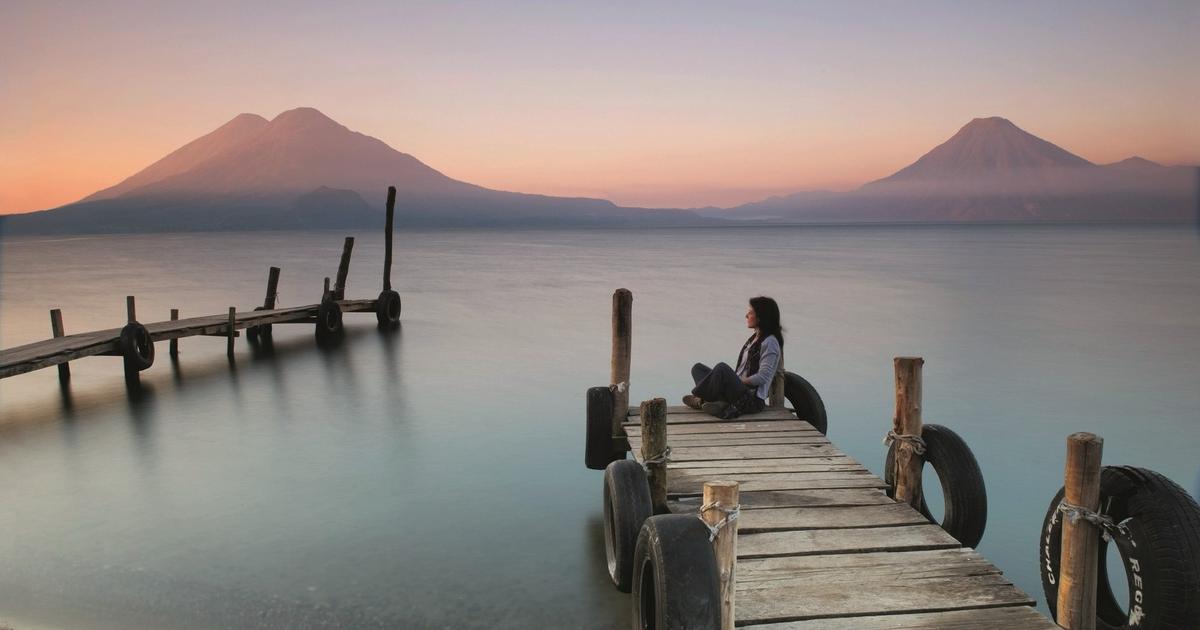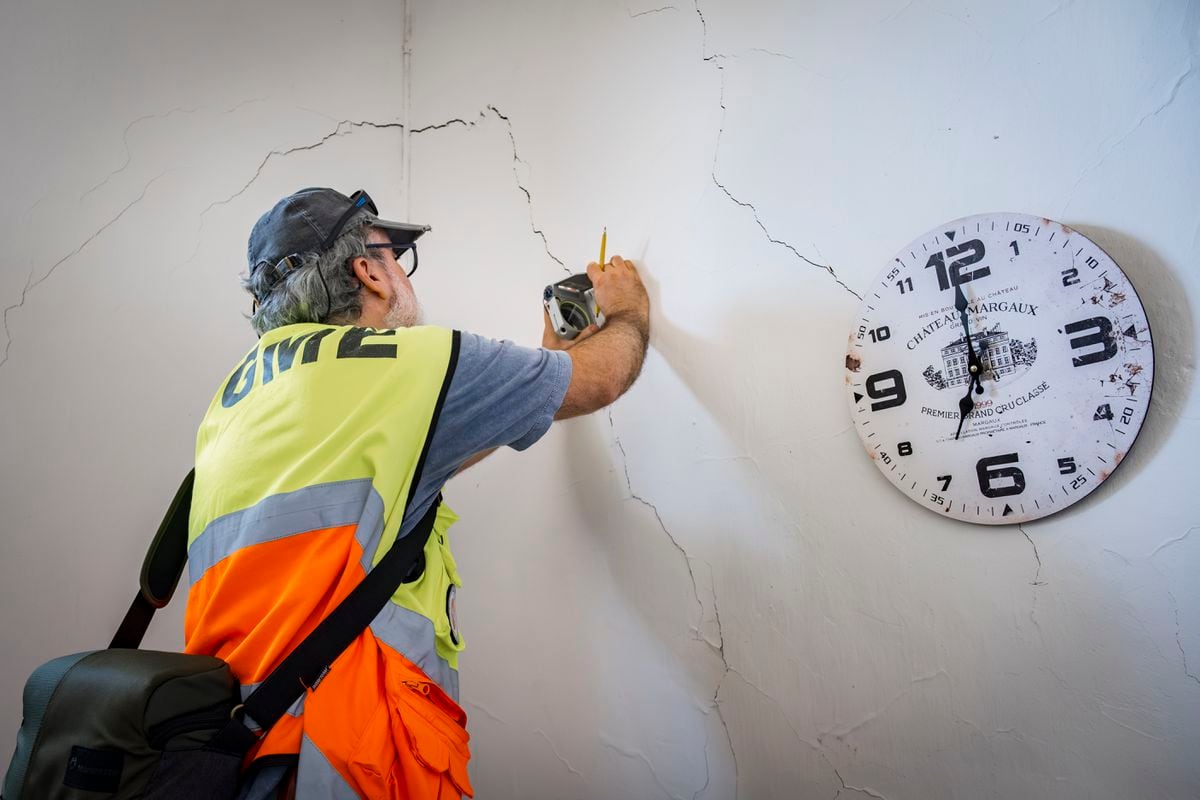View of one of the 3 interior patios of the Santo Domingo 624 mansion, from the mid-18th century, located in the center of Santiago. Cristobal Venegas
The colonial house of María del Rosario Puga y Vidaurre, lover of the architect of Chilean independence, Bernardo O'Higgins, who lived in the property with his wife, is one of the 10 oldest buildings in Santiago de Chile.
Between its adobe walls, built in 1750, their son, Demetrio, was born in 1823. Located in the center of the capital, four blocks from the La Moneda Palace, its impeccable white façade can be seen thanks to the recent work of the Grupo Praedio, a company dedicated to heritage restoration that also took charge of fixing part of the roof.
Once you cross the threshold of the front door, however, the 800-square-meter building, which has survived 14 earthquakes, shows crumbling walls, worn wooden planks and the aftermath of cave-ins.
One of the rooms with old chairs covered in dust and crumbling walls of the Santo Domingo mansion. Cristobal Venegas
Repairing the historic monument, owned by the Instituto de Caridad Hermandad de Dolores, has a cost of 1.2 million dollars.
The value of the house itself is priceless, says doctor Rodrigo Alonso, president of the bicentennial non-profit corporation dedicated to caring for the sick: "It has a story that no one can tell."
The chronicles report that political and social personalities of that time met in the mansion, such as General José de San Martín.
At that time, O'Higgins and the patriot forces dedicated their efforts to combat the royalists and succeed in proclaiming the independence of Chile in 1818.
Santiago was a small city, with less than 100,000 inhabitants, where the upper class lived in adobe buildings and the poor in ranches made of branches.
The collapsed ceiling beams in one of the rooms of the mansion. Cristobal Venegas (© CRISTOBAL VENEGAS)
Four sixty-year-olds circulate courageously this Thursday morning through the corridors of the house seeing scenes and objects that only live in their memory.
They studied elementary school on the premises when it was Public School number 23. They graduated 50 years ago, in 1973, the year of Pinochet's coup against Salvador Allende.
“There was the bell!” one shouts, pointing to an empty corner.
“This was the kitchen.
I remember the huge pots of milk on the stove,” says another, poking her head into a dark, dusty room.
The tablets in the rooms creak with footsteps and the little light that enters reveals holes in the ceilings or scratches on the walls.
There are spaces, even, where the demolition of the beams prevents the passage.
In the third courtyard, the last one,
The evident abandonment of the house is secondary to the memories of a happy time for the group.
"We listened to the story of Bernardo O'Higgins while we studied in a house where he lived... We felt important," says Ruth Jiménez, 62 years old.
Her former classmate, Eduardo Cárdenas, 63, wants to organize a generation reunion at the venue located at 624 Santiago Domingo Street.
Alumni of the old basic school No. 23 tour the Santo Domingo mansion, in the center of Santiago. Cristobal Venegas
Jorge Domínguez, head of the Grupo Praedio restoration project, and María Jesús Guridi, executive director of the company, guide them during the tour and warn them of risk areas.
They comment that during the works several former students asked to take a look, as did tourists and curious passers-by.
For three decades it was school number 23, then it went to another school and then to offices.
The last tenant was a theater school, which the owners kicked out in 2018 with the idea of rescuing the heritage architecture, seriously affected by lack of maintenance.
Jorge Domínguez, head of the Praedio group restoration project, and María Jesús Guridi, executive director of the company, in the Santo Domingo mansion. Cristobal Venegas
The house belongs to the Instituto de Caridad Hermandad de Dolores since 1917. Alonso, president of the corporation, assures that in the first document where he realizes ownership of the property, María del Rosario Puga y Vidaurre appears, where she lived from 1818 until her death. , in 1858. She sold it to Manuel Tagle Gamboa, married to Carlota Correa de Saa, who left it to two of his daughters, Sinforosa and Celinda.
Both gave the property to the institute that had been co-founded in 1815 by their great-uncle, Carlos Correa de Saa.
What to do with it now is the million dollar question, says Alonso.
“We have thought of everything,” he assures, but the main idea is to fix the house and then associate with a company to turn it into an office space for corporations and foundations of the court of which he presides.
On two occasions they have applied for this project to the Cultural Heritage Fund and they have not won it.
He discards the idea of a museum because he believes that there will be no interested public and the maintenance costs would be very high.
“We need something that will contribute (money) to the institute, because its main objective is caring for the sick,” he explains.
The Instituto de Caridad Hermandad de Dolores has six clinics in vulnerable municipalities where they treat patients free of charge.
The money comes from a stock and real estate heritage.
To fix the roof and the facade, almost 250,000 dollars were left.
Those of Grupo Praedio believe that of the 10 colonial mansions still standing in Santiago, where O'Higgins lived is the one in the worst condition.
"If one begins to review these 10 houses, there is little that remains original in several of them," says Guridi, a historian by profession.
This is not the case of the building on Santo Domingo street, where she estimates that 90% of the building is from the 18th century.
The bars on the windows, the hydraulic tiles and the carved wooden moldings, folded to the eaves, are from the Frenchification period.
“It is a historical record.
This architecture shows us the colonial era and vestiges of the 19th century”, she affirms.
Detail of the carved wooden moldings that are folded to the eaves, from the period of Frenchification, in the Santo Domingo mansion. Cristobal Venegas
Domínguez puts his eye on the challenge of restoring this house today, because the current materials are not compatible with the building.
For example, in the eighties and nineties of the last century it became fashionable to cover the adobe walls with a metal mesh that was covered with stucco.
"It works very well, but it hides a very serious damage," he says.
The adobe needs to transfer to the outside the humidity that it has internally and vice versa.
With the stuccos on both sides, they block the transfer and the material loses its consistency, a high risk factor in a seismic zone such as the South American country.
The failures that the house may have are invisible to the eyes of those who studied there.
The group of former students, oblivious to the restoration concerns and overwhelmed with emotion, send photos to the
group of the course of the different corners of their old primary school.
“We want to put a plaque.
Pay homage to this place”, affirms Eduardo Cárdenas.
What the former colleagues want, ultimately, is to treat the property as what it is, even if it doesn't seem like it: a historical monument.
Aerial view of the 18th century roof tiles of the Santo Domingo mansion. Cristobal Venegas

/cloudfront-eu-central-1.images.arcpublishing.com/prisa/IYGZGQHVNVH6NGGLEWJMGFUYXU.jpg)







